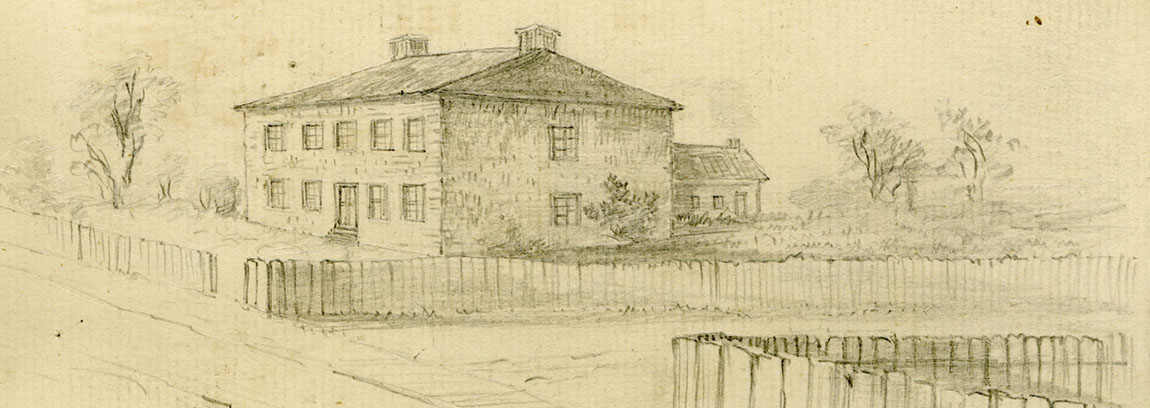Doctor’s response in 1847 typhus epidemic mirrors commitment of front-line workers in COVID-19 pandemic
An Ontario doctor who died from typhus, the disease he sought to treat in thousands of sick and starving Irish immigrants fleeing the Great Famine of 1847, is being commemorated for his sacrifice during one of Toronto’s earliest public health crises. Dr. George Robert Grasett died 174 years ago, just one month into voluntarily caring for the masses who disembarked in Toronto after a gruelling passage from Ireland on so-called coffin ships, in need of treatment for the then-unknown disease.
“This was a massive crisis in the city,” said Robert Kearns, Chair and Founder of the Canada Ireland Foundation which recently opened Grasett Park in downtown Toronto where the first brick General Hospital was built in 1820. “Population of 20,000, suddenly 38,500 newcomers arrive. Many of them would have spoken Gaelic, not English. They wouldn’t have been very fragrant after 60 days at sea below decks in these hideous ships living among human waste and dead bodies. It was beyond imagination. And yet Dr. George Robert Grasett was prepared to come and help these people.”

When typhus reached epidemic proportions, the medical community knew little of the extremely virulent and deadly disease. A bacterial infection transmitted by body lice, it produces symptoms of fever, vomiting and a rash. There was no known cure and, with no medical options to choose from, those on the front lines offered brandy and wine to relieve the fever, as well as poultices, mustard plasters and cold compresses.
“Ideas about how it was transmitted were problematic,” said Laura Smith, lead historical researcher for the foundation’s Grasett Park project. “At the time, many believed it was passed through smell.”
Although he was a man of means, by the time he stepped up to the typhus epidemic’s front lines, Grasett had made it his life’s work to care for the less fortunate. He volunteered at the Toronto General Dispensary from which he handed out free medicines and advice to the needy. It is believed he refused compensation for medical services.
When it became known that sick and needy newcomers were arriving daily to Toronto in the late summer and fall of 1847, Grasett sought out and was granted by the city’s Board of Health an appointment as Medical Superintendent of the new Emigrant Hospital.
“He became aware of the arrival of migrants and he decided that was his calling,” Kearns said. But after only 30 days in the line of duty, Grasett succumbed to typhus himself.
The British American Medical and Physical Journal wrote about his legacy after this death “in the humble abodes of the suffering poor of this large town, in the reception room of the Dispensary where his benevolent smile was wont to greet them, his virtues are the themes of daily praise and his death the subject of deep and lasting sorrow.” Health care in Canada today has its roots in this little-told moment in history. In many ways, it is where public health and universal medicine start.
While these Irish immigrants were not wanted at the time in the U.S., they were welcomed to Canada, quarantined, cared for if they were sick, buried if they died and helped to find work and reunited with family if they survived. Civil society came to the aid of immigrants in need, and doctors, nurses and orderlies recognized that everyone deserves access to health care.
“It’s hard to imagine what they were thinking at that time,” said Dr. Natalie Wolpert, a Toronto emergency room physician, who sees parallels in the response from the medical community to the typhus epidemic in 1847 and today’s response to the COVID-19 pandemic. “It’s a challenge when you have to look at whether there are personal risks to yourself and your family. I can only imagine it, being in a lesser but similar scenario now with COVID.”
Dr. Wolpert says physicians today feel the same responsibility to care for those in need despite the risk to themselves.
“There were times during COIVD when we didn’t understand how to protect ourselves, how to protect our patients but we still had that sense of obligation and determination to continue…That underlying sense of obligation we take from these historical figures who faced things that were much more difficult than we were exposed to.”
Nestled at the intersection of Adelaide and Widmer streets in Toronto’s downtown, it features glass panels imprinted with the cheesecloth that was used to protect patients from flies and granite blocks engraved with the name George Robert Grasett and others who sacrificed their lives for strangers many generations before. Kearns said while it bears Dr. Grasett’s name, the park is a celebration of all front-line workers, those of today, as well as those of this bygone era.
“He set a standard in what he did and how he did it,” said Kearns of Grasett’s lasting legacy. “It wasn’t for hire or reward. It wasn’t for fame. It was just because he felt that was his Hippocratic duty; not only do no harm but come to the aid of those in great distress and in illness. It’s such a wonderful noble act that he did.”
Top image: Grasett Park is a celebration of the Toronto doctors, nurses, and other hospital workers who died in 1847 caring for Irish immigrants stricken with typhus. Situated at Adelaide and Widmer Streets in Toronto’s downtown, it features glass panels imprinted with a cheesecloth pattern, recalling the material used to protect patients from heat and flies. (Image courtesy of the Canada Ireland Foundation)